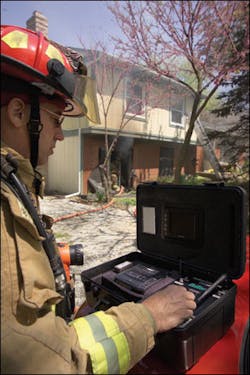Without question, thermal imagers (TIs) have revolutionized the way modern firefighters perform their tasks. Firefighters using TIs are now able to see what smoke has hidden from their predecessors. The TI helps firefighters see fire behind walls and locate victims lost in smoke. Normally, only the firefighters near the TI can benefit from its image. However, thermal imagers can be equipped with a wireless video transmitter that allows firefighters to share the TI image with incident commanders. Proper use of this tool can help officers and firefighters make better, more informed decisions.
The Basics
Every fire service TI is available with a remote video transmission system. Many of the systems on the market must be installed by the manufacturer, although a fair number of TIs allow the user to buy and add a transmitter at his convenience. These systems operate in the 2.4 GHz frequency range, which is a domain used by a number of household items (including certain cordless telephones).
The transmission system can be analog or digital; neither is inherently better than the other, as each has specific advantages. Digital systems are "all or nothing," which means that they will generate a very good image or none at all. Analog systems can have static that indicates interference; however, poor signals may still be visible through the static.
Most wireless transmitters send a 300-400-megawatt signal, which is about 1/15th the strength of a firefighter's normal portable radio. Most transmitters offer a normal transmitting distance of about 300 feet through a standard wood-frame residence. Heavier construction or a great number of walls and obstacles between the transmitter and receiver will reduce the effective distance.
Three basic receiver systems are available on the market. Fixed receivers are hardwired into a vehicle's power supply and connected to a larger antenna. Some manufacturers offer portable receiver systems, which are self-contained and allow a commander to set up the equipment quickly and easily at a chosen location. There are also mobile receiver systems, which are compact receiver/display components that allow the user to employ the product while he is moving on scene. The performance of all three types of systems can be enhanced by ensuring as clear a line as possible between the transmitter and the receiver antenna. The portable and mobile systems will perform better with a fully charged battery than with a partially discharged one. When using one of these systems, be sure to carry a spare battery, just in case reception degrades due to lower power.
The Uses
By transmitting a thermal image to another location, interior firefighters can gain a number of advantages. For example,
- Incident commanders (ICs) can "see" what their fire companies are seeing. This allows the IC not only to provide guidance to interior companies, but also to observe interior heat conditions. The incident commander can determine if interior operations are still acceptable by identifying improving or deteriorating conditions. He can also monitor changes within the incident to evaluate his strategies and tactics.
Challenges
There are two primary obstacles to using a wireless transmitter during emergency incidents: set-up time and manpower. Portable and mobile receiver systems eliminate the majority of set-up time. Fixed receiver systems can be permanently wired in place to eliminate set-up time. If the system must be set up and connected at an incident, firefighters can speed the assembly process by using color-coded tape to indicate which fittings belong on which attachment ports.
Manpower to handle transmitter and receiver operations is a more difficult challenge, one that cannot be addressed in a uniform fashion. While manpower is probably the most common and most obvious obstacle related to the use of transmitters, relatively few departments plan how to overcome it. Failure to plan guarantees failure to execute, so take time to develop a system that will work within the confines of your overall system. In some locations, it may be sufficient to train regularly on coordinated TI use, transmitter operations and fire operations. Other departments may need to divide some scene responsibilities, possibly appointing more sector officers to assume more operational responsibilities. Some departments may need a "chief's aide" to help monitor IC responsibilities, including managing the transmitted signal. Each department needs to find its own solution.
Conclusion
The wireless transmitter is a common accessory, but it is generally not used as effectively as it could be. If fire departments plan their operations around TI use and train incident commanders on how to incorporate image reception into their tactics, they can improve the safety and effectiveness of their operations. For tips on improving the performance of a wireless system, visit the Technology section of Firehouse.com.
Jonathan Bastian is a thermal imaging training specialist for Bullard. He is certified as a thermal imaging instructor by the Law Enforcement Thermographers' Association (LETA), the international public safety organization specializing in thermal imager certification and training. He is also the author of the FD Training Network "FireNotes" book, Thermal Imaging for the Fire Service. Educated at Brown University and licensed as a high school teacher in Illinois, Bastian served 12 years on the North Park, IL, Fire Department, including the last three as a captain. As health and safety officer, he led the development and implementation of the department's rapid intervention team SOG. Bastian is a certified Fire Instructor I and Firefighter III, and he spent 12 years as an EMT-I/D. He has taught classes on thermal imaging, rapid intervention teams and search and rescue operations. He is currently a public safety official in Central Kentucky. If you have questions about thermal imaging, please send them to [email protected].





